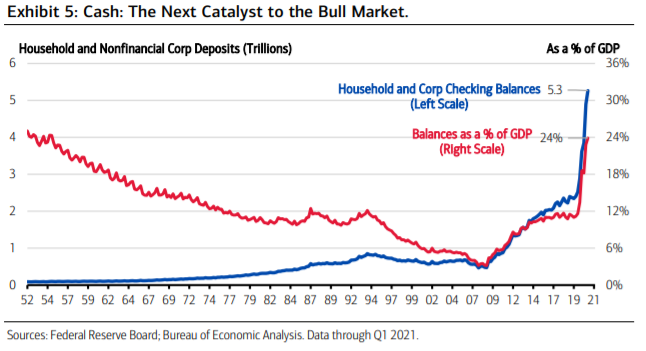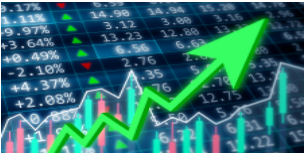Der er mangel på alt – fra chips til støvsugere. Men der er ikke mangel på penge. Likviditeten hos de amerikanske forbrugere og virksomheder har ikke været så stor siden 50’erne, skriver Merrill. Et vanvittigt beløb på 5.300 milliarder dollar i cool cash! Det skyldes høj indtjening samt udskudt forbrug, og pengene skal ud og arbejde, og derfor tror Merrill, at det vil stimulere det amerikanske aktiemarked trods nok så megen modvind, og det vil også føre til højere kurser og et højere afkast.
One Thing Not in Short Supply: Cash
Chips, cans, cars, cleaners—you name it, and it is in short supply, throttling near-term
economic growth and earnings prospects not only in the U.S. but around the world.
However, not lacking is cash and hence our conviction that U.S. Equities remain in an
uptrend, notwithstanding some mounting headwinds.
Capital is the oxygen of the economy and capital markets, and, as Exhibit 5 highlights, the
amount of liquidity presently held by U.S. corporations and American households—on an
absolute or relative basis—has never been higher, totaling a staggering $5.3 trillion as of
Q1 of this year.
According to the latest Flow of Funds data, corporate checking accounts
totaled $1.9 trillion6 at the end of Q1 of 2021, while households were sitting on $3.35
trillion. The combined figure equates to 24% of U.S. GDP, a level not seen since the 1950s.

Multiple reasons explain the surfeit of cash, ranging from stronger-than-expected profits
growth, deferred capital expenditures (CapEx) spending as the coronavirus Delta variant
has spread, generous government transfers to U.S. households, ultra-low interest rates,
and rising wages, among the primary reasons.
What does all of this mean for the markets? First, we believe concerns of “fiscal cliff” are
overdone—i.e., when both Congress and the Fed step back from priming the
fiscal/monetary pump, U.S. households and corporations will have the financial
wherewithal to keep the economy humming at a solid clip.
The upshot: more upside earnings surprises.
Second, hoards of corporate cash entails rising CapEx spending into
2022 (bullish for the U.S. Technology sector) and increasing levels of share buybacks and
dividend growth.
And third, in terms of portfolio construction, rising levels of consumer
spending and CapEx into 2022 support our barbell approach to owning cyclicals (Energy,
Materials, Industrials and Financials), as well as secular growth leaders like Technology and
Healthcare.
The bottom line: The common refrain is that “cash is trash.” That’s not untrue in a lowyielding world.
However, think of present cash levels as a future catalyst to higher U.S.
Equity prices/returns.




